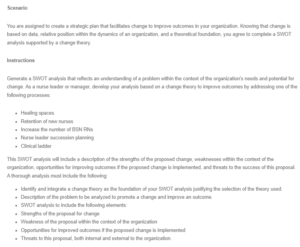NUR 4590 – Deliverable 6 – SWOT Analysis for Nurse Leaders
As a leader in this organization, I would like to show the strengths, weaknesses, opportunities, and threats to increasing the number of BSN RNs. In 2011, The Future of Nursing recommended increasing the number of nurses with degrees at a bachelor’s level or higher to 80% (National Academies of Sciences, Engineering, and Medicine. 2021. pg. 200). This goal was not met; however, the percentage did increase. Let’s discuss how this proposal could affect the organization.
Strengths
Strengths that can be contributed to increasing our amount of BSN-educated nurses include:
- Decreased readmission rates
- Reduced adverse events
- Lower mortality rates
- Improved client outcomes
According to an article published in the International Journal of Environmental Research and Public Health, a study was completed that documented the benefit of increasing the number of BSN-educated nurses at the staff level. This study documented shorter hospital stays in relation to BSN-educated nursing care. Horter hospital stays as well as all strengths noted above from this study could benefit the hospital financially a well as improving client outcomes and care (Wieczorek-Wójcik, B.et al. 2022. Pg. 2).
Weakness
A weakness of this proposed change is the ability of associate-educated nurses to be able to obtain their BSN degree. There are many barriers that can contribute to further education in the nursing field. This is one of the reasons that the recommended education increase goal was not met. Some of these barriers for these nurses include time, money, and childcare availability (National Academies of Sciences, Engineering, and Medicine. 2021. pg. 200). Many RN to BSN programs can be completed online but will often require some additional clinical hours. These clinical hours can often be difficult to obtain due to a busy schedule without the addition of schooling. Also, nursing school, whether it is a 2-year or 4-year degree program, is very costly. Once finished with a 2-year program, many individuals do not want to incur any more financial debt and forgo the opportunity to further their education in place of working full-time to repay debt.
NUR 4590 – Deliverable 6 – SWOT Analysis for Nurse Leaders
Opportunity
Opportunities that could happen in relation to this change are the ability to retain nursing staff, promote from within, further nursing education, and advance education levels. The BSN-educated nurse can fulfill leadership roles within the organization. This ability can show an opportunity to retain nursing staff and promote from within the trusted and loyal staff that is already available. Also, nurses with a higher level of education show the ability and desire to further their education, which could lead to advanced nursing degrees such as MSN, CNP, and DNP. Nurses with these educational levels can provide the organization with the opportunity to provide higher levels of staff education and improvement (National Academies of Sciences, Engineering, and Medicine. 2021. pg. 280). These nurses are educated to the highest level and can hold educational training to improve nursing staff skills and improve client care.
Threats
Threats that this change could pose if implementation does occur could include higher wages and possible nursing shortage. BSN-educated nurses have a higher level of education, which in turn means they will require a higher level of pay than lower graduate degree nurses. There will still be a need for support staff, such as LPNs and CNAs. If finances are a concern, the organization could do a further analysis of finances and potential cost savings related to decreased hospital readmissions and decreased hospital stay length (Wieczorek-Wójcik, B. et al., 2022). The other threat is the nursing shortage, which is a possibility since there are fewer BSN-educated nurses than nurses with associate degrees (National Academies of Sciences, Engineering, and Medicine 2021).
References
National Academies of Sciences, Engineering, and Medicine (2021). The Future of Nursing 2020-2030: Charting a Path to Achieve Health Equity. Washington, DC: The National Academies Press. https://doi.org/10.17226/25982.
Wieczorek-Wójcik, B., Gaworska-Krzemińska, A., Owczarek, A., Wójcik, M., Orzechowska, M., & Kilańska, D. (2022). The Influence of Nurse Education Level on Hospital Readmissions-A Cost-Effectiveness Analysis. International Journal of Environmental Research and Public Health, 19(7). https://doi.org/10.3390/ijerph19074177
ORDER A PLAGIARISM-FREE PAPER HERE
We’ll write everything from scratch
Question 
NUR 4590 – Deliverable 6 – SWOT Analysis for Nurse Leaders
Scenario
You are assigned to create a strategic plan that facilitates change to improve organizational outcomes. Knowing that change is based on data, relative position within the organization’s dynamics, and a theoretical foundation, you agree to complete a SWOT analysis supported by a change theory.

NUR 4590 – Deliverable 6 – SWOT Analysis for Nurse Leaders
Instructions
Generate a SWOT analysis that reflects an understanding of a problem within the context of the organization’s needs and potential for change. As a nurse leader or manager, develop your analysis based on a change theory to improve outcomes by addressing one of the following processes:
- Healing spaces
- Retention of new nurses
- Increase the number of BSN RNs
- Nurse leader succession planning
- Clinical ladder
This SWOT analysis will include a description of the strengths of the proposed change, weaknesses within the context of the organization, opportunities for improving outcomes if the proposed change is implemented, and threats to the success of this proposal. A thorough analysis must include the following:
- Identify and integrate a change theory as the foundation of your SWOT analysis justifying the selection of the theory used.
- Description of the problem to be analyzed to promote a change and improve an outcome.
- SWOT analysis to include the following elements:
- Strengths of the proposal for change
- Weakness of the proposal within the context of the organization
- Opportunities for improved outcomes if the proposed change is implemented
- Threats to this proposal, both internal and external to the organization.